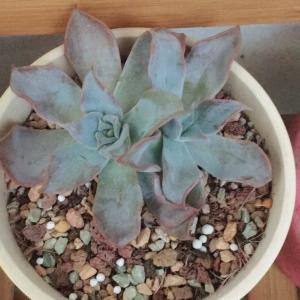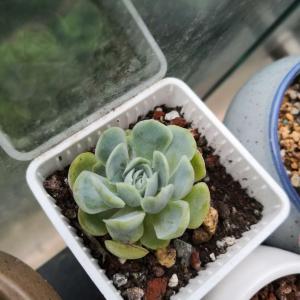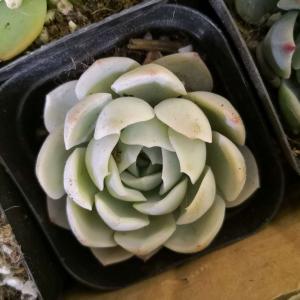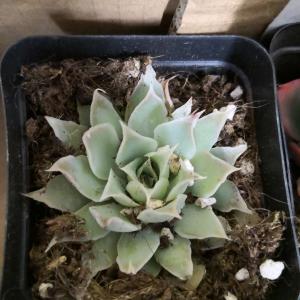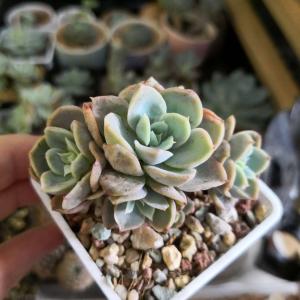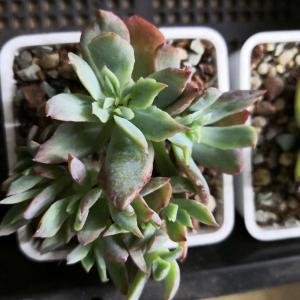文章
权问薇
2018年05月22日

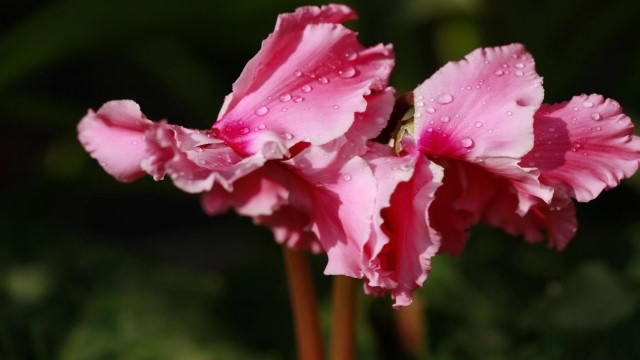
一、养殖环境
1、土壤:疏松、肥沃的土壤适合仙客来生长,在栽植的时候要将培养土进行消毒。
2、施肥:一般10-15天施一次即可,在翻盆和换土时可以适量施点基肥,施肥一定要薄肥勤施,在夏季温度较高时要停止施肥。
3、浇水:生长期间要保持土壤微微湿润,盆内不能有积水。夏季若是没有继续生长,可以正常浇水。
4、温度:仙客来在冬季适宜温度为10-22℃,昼夜温差不能超过10℃。夜间温度为8℃时可以正常开花,不过花期会减短,若低于6℃它就没有办法正常开花。
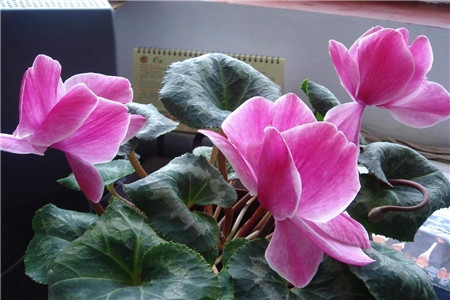
二、繁殖方法
1、播种繁殖:要先将种子消毒,再将它泡在温水中24小时,播种时种子间距为1-2厘米,浇水后将它放在阴暗的环境,温度最好控制在18℃,用薄膜将其包住,20天左右就会发芽。
2、切茎繁殖:球茎的直接要3厘米以上并有两处以上芽眼,才可以分割,分割刀具要进行消毒,直切到根部,切口处涂上草木灰,晾干之后就可以进行栽植了。
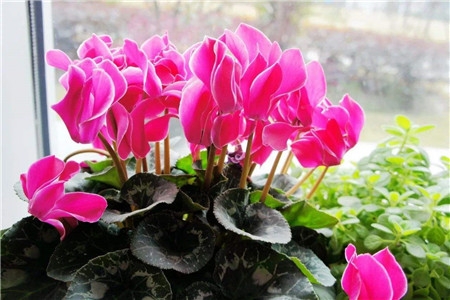
三、常见病虫害
1、常见的虫害:蚜虫、红蜘蛛及卷叶虫等,可以用呋喃丹进行防治。
2、常见的病害:叶斑病、软腐病等,发病的时候可以用托布津水溶液进行喷洒治疗。

1
1
文章
巴黎铁塔
2018年05月22日
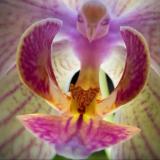
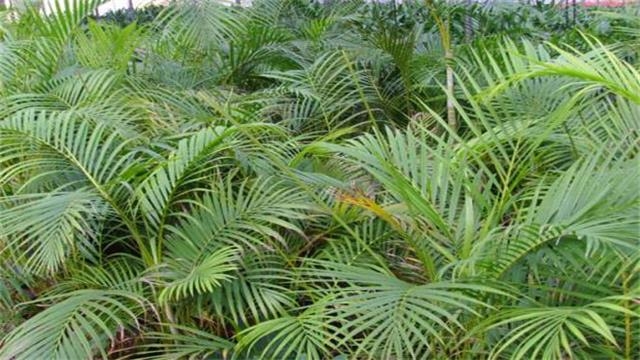
1.合理浇水
散尾葵茎叶长得较高,叶子需要的养分和水主要依靠根茎输送。适量多浇水,根部能够加快吸收速度,有利于叶子生长,但是如果泥土太过潮湿,就会减弱根的呼吸作用,阻碍水分的吸收,最终导致叶片发黄。
水太多不可以,同样太少了也不行,它在生长的过程中需要足够的水,若是泥土较长时间缺乏水,其生长所必须的水难以保障,也会造成叶子发黄。
所以,在平时的时候要合理控制浇水的量,不能浇太多水,也不能浇太少。

2.避免日光直射
其正常生长需要足够的日光,但在夏天日光过于强烈时要进行适当的遮阴,在此期间如果不进行遮阴极易导致植物的叶子被日光烧伤,这就是植物夏季常见的日灼病,叶子会变焦发黄。如果不及时采取有效措施,整株植物都会枯萎。
所以夏天的时候可以将植物搬入阴凉处或大树底下,不要直接照射阳光。
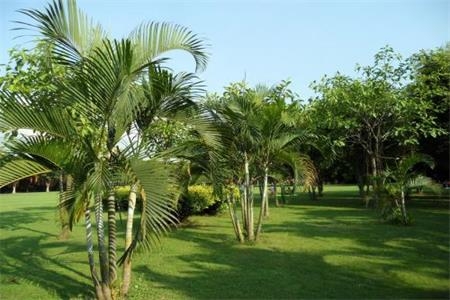
3.防治病虫害
叶螨、介壳虫等是其比较容易感染的有害的虫子,它的叶子感染了介壳虫或者叶螨时,害虫会对植物造成损害,它的叶子也就开始变黄。一旦发现就要及时用药物进行治疗,否则可能会造成其死亡。

1
2
文章
Miss Chen
2018年05月21日

Description: This herbaceous perennial plant is ½–1½' tall, branching occasionally. The leafy stems have a tendency to lean to one side or sprawl across the ground. The stems are light green to reddish green, glabrous to hairy, and often somewhat angular. The alternate compound leaves are simple odd-pinnate and up to 8" long, consisting of about 5-15 leaflets. The petioles and rachises of these compound leaves are light green to reddish green and glabrous to hairy; they are grooved above and convex below. The leaflets are ¾-1¼" long and about one-third as much across; they are elliptic to broadly elliptic-oblong, smooth (entire) along their margins, medium green, glabrous (or nearly so), and sessile (or nearly so). The upper stems terminate in rather loose panicles of floppy or nodding flowers spanning 1½-3" across. Some panicles are also produced from the axils of upper leaves on long peduncles up to 6" long. The pedicels are up to 1" long.
Both the peduncles and pedicels of these panicles are light green to reddish green and glabrous to hairy. The campanulate (bell-shaped) flowers are up to 16 mm. (2/3") across. Each flower has 5 rounded petals that are light blue-violet, a short-tubular calyx with 5 triangular teeth, 5 stamens with white anthers, and a pistil with a slender white style that become tripartite toward its tip. The calyx is light green to reddish purple and glabrous to hairy. There are fine veins that run along the length of the petals. The stamens are the same length as, or shorter than, the petals of the flowers. The blooming period usually occurs during the late spring, lasting about 2-3 weeks. Afterwards, the flowers are replaced by 3-celled seed capsules; these capsules are about 6 mm. (¼") in length and ovoid in shape; they are few-seeded. The root system consists of a short vertical crown with abundant fibrous roots. This plant spreads by reseeding itself.

Cultivation: The preference is light shade or dappled sun, more or less mesic conditions, and loamy soil with decaying organic matter. This plant is not aggressive; it is able to adapt to somewhat shady gardens that are located near deciduous trees.
Range & Habitat: The native Jacob's Ladder is an occasional to locally common plant that occurs in most areas of Illinois, except for some counties in the central portion of the state (see Distribution Map). Habitats include deciduous woodlands, lower wooded slopes, bases of bluffs, shaded banks of streams and rivers, bottoms of sandstone canyons, and areas along woodland paths. Jacob's Ladder is found in higher quality natural habitats that are dominated by various deciduous trees.

Faunal Associations: The nectar and pollen of the flowers attract bees primarily, including honeybees, bumblebees, little carpenter bees (Ceratina spp.), mason bees (Osmia spp.), cuckoo bees (Nomada spp.), Halictid bees (Augochlorella spp., Lasioglossum spp.), and Andrenid bees (Andrena spp.). A species from this last group, Andrena polemonii, is a specialist pollinator (oligolege) of Polemonium spp. (Jacob's Ladder, Greek Valerian). The flowers are also visited by Bombylius major (Giant Bee Fly), butterflies, skippers, and moths, which seek nectar. The larvae of two moths, Coleophora polemoniella and Scrobipalpula polemoniella, mine the leaflets. An aphid, Nasonovia hottesi, sucks the sap of these plants.

Photographic Location: A flower garden at Crystal Lake Park in Urbana, Illinois.
Comments: This is a rather floppy plant, although both the flowers and foliage are quite attractive. The bell-shaped flowers and compound leaves together provide Jacob's Ladder with a distinctive appearance. The only other species that resembles it, Polemonium vanbruntiae (Greek Valerian), which is native to some of the Eastern States, doesn't occur in the wild in Illinois. This latter species is more erect in habit, and it has slightly larger flowers with exerted stamens. The flowers of this latter species are usually a darker shade of blue than those of Jacob's Ladder. The common name of Polemonium reptans refers to the pairs of opposite leaflets on the compound leaves, which supposedly resemble a series of steps on a ladder in a dream by the biblical Jacob.
Both the peduncles and pedicels of these panicles are light green to reddish green and glabrous to hairy. The campanulate (bell-shaped) flowers are up to 16 mm. (2/3") across. Each flower has 5 rounded petals that are light blue-violet, a short-tubular calyx with 5 triangular teeth, 5 stamens with white anthers, and a pistil with a slender white style that become tripartite toward its tip. The calyx is light green to reddish purple and glabrous to hairy. There are fine veins that run along the length of the petals. The stamens are the same length as, or shorter than, the petals of the flowers. The blooming period usually occurs during the late spring, lasting about 2-3 weeks. Afterwards, the flowers are replaced by 3-celled seed capsules; these capsules are about 6 mm. (¼") in length and ovoid in shape; they are few-seeded. The root system consists of a short vertical crown with abundant fibrous roots. This plant spreads by reseeding itself.

Cultivation: The preference is light shade or dappled sun, more or less mesic conditions, and loamy soil with decaying organic matter. This plant is not aggressive; it is able to adapt to somewhat shady gardens that are located near deciduous trees.
Range & Habitat: The native Jacob's Ladder is an occasional to locally common plant that occurs in most areas of Illinois, except for some counties in the central portion of the state (see Distribution Map). Habitats include deciduous woodlands, lower wooded slopes, bases of bluffs, shaded banks of streams and rivers, bottoms of sandstone canyons, and areas along woodland paths. Jacob's Ladder is found in higher quality natural habitats that are dominated by various deciduous trees.

Faunal Associations: The nectar and pollen of the flowers attract bees primarily, including honeybees, bumblebees, little carpenter bees (Ceratina spp.), mason bees (Osmia spp.), cuckoo bees (Nomada spp.), Halictid bees (Augochlorella spp., Lasioglossum spp.), and Andrenid bees (Andrena spp.). A species from this last group, Andrena polemonii, is a specialist pollinator (oligolege) of Polemonium spp. (Jacob's Ladder, Greek Valerian). The flowers are also visited by Bombylius major (Giant Bee Fly), butterflies, skippers, and moths, which seek nectar. The larvae of two moths, Coleophora polemoniella and Scrobipalpula polemoniella, mine the leaflets. An aphid, Nasonovia hottesi, sucks the sap of these plants.

Photographic Location: A flower garden at Crystal Lake Park in Urbana, Illinois.
Comments: This is a rather floppy plant, although both the flowers and foliage are quite attractive. The bell-shaped flowers and compound leaves together provide Jacob's Ladder with a distinctive appearance. The only other species that resembles it, Polemonium vanbruntiae (Greek Valerian), which is native to some of the Eastern States, doesn't occur in the wild in Illinois. This latter species is more erect in habit, and it has slightly larger flowers with exerted stamens. The flowers of this latter species are usually a darker shade of blue than those of Jacob's Ladder. The common name of Polemonium reptans refers to the pairs of opposite leaflets on the compound leaves, which supposedly resemble a series of steps on a ladder in a dream by the biblical Jacob.
0
0
文章
Miss Chen
2018年05月21日

Description: This herbaceous perennial plant is 1–1½' tall. Infertile plants are unbranched, producing a single leaf from a long stalk, while fertile plants produce a pair of leaves on long petioles at the apex of this stalk. The stalks are light green to pale reddish green, glabrous, and terete (circular in circumference). The leaves of infertile plants are up to 1' long and 1' across; they are orbicular in outline, fully peltate, and deeply divided in 6-9 palmate lobes. The leaves of fertile plants are similar, although they are less orbicular in outline, only marginally peltate, and they tend to have fewer lobes (typically 5-6). The leaves of both infertile and fertile plants have lobes that are obovate in shape. The outer margins of these lobes are coarsely dentate and often shallowly cleft; less typically, they are coarsely crenate, slightly undulate, or smooth (entire). The upper leaf surface is medium to dark green and glabrous. On fertile plants, the ascending petioles of the leaves are 3-6" long, light green to pale reddish green, glabrous, and terete. The petioles join the leaf blades toward the inner margins of the latter. Each fertile plant produces a single nodding flower where the 2 petioles branch from each other.
This flower is about 1½" across, consisting of 6-9 white petals, 6 light green sepals, 12-18 stamens, and a superior ovary with a dome-shaped cluster of stigmata at its apex. Both the petals and sepals are oval-obovate in shape; the latter are glabrous and early-deciduous. The ovary is ovoid in shape and light green to pale yellow. The stamens have white filaments and yellow anthers. The pedicel of the flower is about 1½" long, light green to yellowish green, and glabrous. The blooming period occurs from mid- to late spring, lasting about 2-3 weeks. Individual flowers are short-lived; they have a pleasant fragrance. Each flower is replaced by an ovoid berry that is fleshy and contains several seeds. At maturity, this berry is about 1½" long and pale yellow. A berry is produced only when cross-pollination of the flower occurs. The root system is long-rhizomatous and fibrous. Mayapple often produces dense colonial colonies that exclude other spring-flowering plants.
Cultivation: The preference is dappled sunlight to light shade, moist to slightly dry conditions, and a rich loamy soil with abundant organic matter. This plant is easy to start from rhizomes and it will readily adapt to garden areas near deciduous trees. It is a strong colonizer and may spread aggressively in some situations. Young foliage is vulnerable to late-frost damage. The mature foliage dies down by the end of summer.

Range & Habitat: The native Mayapple is a common plant that occurs in every county of Illinois (see Distribution Map). It is found primarily in mesic deciduous woodlands, open woodlands, small woodland openings, savannas, and edges of hillside seeps in wooded areas. Mayapple occurs in high quality old-growth woodlands and also open woodlands that have some history of disturbance.
Faunal Associations: The flowers are cross-pollinated by bumblebees and other long-tongued bees. These insects collect pollen and possibly suck nectar. The larvae of a sawfly, Aglaostigma quattuordecimpunctatum, feed on the leaves of Mayapple (Smith, 2006). Adults of a thrips, Ctenothrips bridwelli, have been found on the foliage (Stannard, 1968). The foliage of Mayapple is avoided by mammalian herbivores because of its poisonous qualities and bitter taste. The seeds and rhizomes are also poisonous. The berries are edible if they are fully ripe; they are eaten by box turtles and possibly by such mammals as opossums, raccoons, and skunks. The seeds are distributed to new locations in the feces of these animals.

Photographic Location: A mesic deciduous woodland at Busey Woods in Urbana, Illinois.
Comments: Mayapple is a familiar woodland plant with interesting foliage. The flowers are large and attractive, but they are sparingly produced and mostly hidden by the large leaves. Mayapple develops very quickly during the warmer days of spring. There is no other plant within the state that resembles it; the only other species in this genus occurs in Asia. People can eat the ripe berries in limited amounts, even though they may be mildly toxic. The flavor is bland and resembles an overripe melon.
This flower is about 1½" across, consisting of 6-9 white petals, 6 light green sepals, 12-18 stamens, and a superior ovary with a dome-shaped cluster of stigmata at its apex. Both the petals and sepals are oval-obovate in shape; the latter are glabrous and early-deciduous. The ovary is ovoid in shape and light green to pale yellow. The stamens have white filaments and yellow anthers. The pedicel of the flower is about 1½" long, light green to yellowish green, and glabrous. The blooming period occurs from mid- to late spring, lasting about 2-3 weeks. Individual flowers are short-lived; they have a pleasant fragrance. Each flower is replaced by an ovoid berry that is fleshy and contains several seeds. At maturity, this berry is about 1½" long and pale yellow. A berry is produced only when cross-pollination of the flower occurs. The root system is long-rhizomatous and fibrous. Mayapple often produces dense colonial colonies that exclude other spring-flowering plants.
Cultivation: The preference is dappled sunlight to light shade, moist to slightly dry conditions, and a rich loamy soil with abundant organic matter. This plant is easy to start from rhizomes and it will readily adapt to garden areas near deciduous trees. It is a strong colonizer and may spread aggressively in some situations. Young foliage is vulnerable to late-frost damage. The mature foliage dies down by the end of summer.

Range & Habitat: The native Mayapple is a common plant that occurs in every county of Illinois (see Distribution Map). It is found primarily in mesic deciduous woodlands, open woodlands, small woodland openings, savannas, and edges of hillside seeps in wooded areas. Mayapple occurs in high quality old-growth woodlands and also open woodlands that have some history of disturbance.
Faunal Associations: The flowers are cross-pollinated by bumblebees and other long-tongued bees. These insects collect pollen and possibly suck nectar. The larvae of a sawfly, Aglaostigma quattuordecimpunctatum, feed on the leaves of Mayapple (Smith, 2006). Adults of a thrips, Ctenothrips bridwelli, have been found on the foliage (Stannard, 1968). The foliage of Mayapple is avoided by mammalian herbivores because of its poisonous qualities and bitter taste. The seeds and rhizomes are also poisonous. The berries are edible if they are fully ripe; they are eaten by box turtles and possibly by such mammals as opossums, raccoons, and skunks. The seeds are distributed to new locations in the feces of these animals.

Photographic Location: A mesic deciduous woodland at Busey Woods in Urbana, Illinois.
Comments: Mayapple is a familiar woodland plant with interesting foliage. The flowers are large and attractive, but they are sparingly produced and mostly hidden by the large leaves. Mayapple develops very quickly during the warmer days of spring. There is no other plant within the state that resembles it; the only other species in this genus occurs in Asia. People can eat the ripe berries in limited amounts, even though they may be mildly toxic. The flavor is bland and resembles an overripe melon.
0
0
文章
Miss Chen
2018年05月21日

Description: This herbaceous perennial plant is about 1½–3' tall. It is more or less erect and either sparingly branched or unbranched. The stems are light green to dark purple, angular-terete, and slightly pubescent. Pairs of opposite leaves occur along each stem. The leaf blades are up to 5" long and 2½" across; they are dull green, hairless, ovate in shape, and crenate-dentate along their margins. The lower leaves have slender petioles up to one-half the length of their blades, while the upper leaves have much shorter petioles.
The upper stems terminate in slender spike-like racemes of flowers up to 1' long. In addition, secondary racemes are often produced from the uppermost pairs of leaves. The flowers are arranged in opposite pairs along the upper one-half or upper one-third of each raceme. The central stalk of the raceme is usually dark purple. Each flower is up to 1/3" (8 mm.) in length; it consists of a tubular-ovoid calyx and a slender corolla that is pale purplish white and divides into two lips. The small upper lip has a rounded edge, which is slightly indented in the middle; the long lower lip divides into 3 lobes, functioning as a landing pad for visiting insects. Within the corolla, there is a single style and 4 stamens. The small calyx is light green and hairless; it has 3 teeth that are long, slender, and purple along its upper/outer side, while the opposite side of the calyx has a pair of much smaller teeth. The pedicels of the flowers are very short; at the base of each pedicel, there is a pair of tiny bracts (bracteoles). While individual flowers are blooming, they are held horizontally; shortly afterwards, their corollas fall away and their calyces bend downward to become appressed against the stalk of their racemes. The blooming period occurs during the summer and lasts 1-2 months. Only a few flowers are in bloom at the same time. Each flower produces a single seed that develops within the calyx. This plant reproduces by reseeding itself.
Cultivation: Lopseed prefers a sheltered location that provides light to medium shade, moist to mesic conditions, and a rich woodland soil with abundant organic matter.

Range & Habitat: The native Lopseed has been found in most counties of Illinois, however it is only occasionally encountered and its populations are scattered (Distribution Map). Habitats include rich deciduous woodlands in moist to mesic conditions. Lopseed is largely restricted to higher quality woodlands where the original ground flora is still intact. While it is little known, Lopseed has a wide distribution in North America and east-central Asia.
Faunal Associations: Small bees occasionally visit the flowers for nectar. Robertson (1928) observed only two bees, Ceratina dupla and Augochlorella striata, as floral visitors of Lopseed. The former species is a Little Carpenter bee, while the latter species is a Green Metallic bee. Other records of floral-faunal relationships are sparse. A polyphagous insect, Proxys punctulatus (Black Stink Bug), sucks juices from the foliage of Lopseed (and many other plants). White-Tailed Deer reportedly dislike this plant as a food source and don't graze on the foliage.
Photographic Location: Spitzler Woods in Macon County, Illinois. The photographs were taken during the autumn when the flowers were no longer in bloom.

Comments: This woodland plant is often overlooked because it lacks showy flowers. As a general rule, shade-loving woodland plants that bloom during the summer have small light-colored flowers because they have access to very limited amounts of energy from low levels of sunlight. Plants that grow in open woodlands or prairies have access to more sunlight and usually produce larger flowers. Woodland wildflowers that bloom in the spring can also produce large showy flowers, largely because the canopy trees haven't fully developed their leaves, and thus more sunlight reaches the ground vegetation. Lopseed is an unusual plant that has been assigned to its own plant family. It resembles members of the Mint family (Lamiaceae) in many ways, but each of its flowers produces only a single seed. In contrast, individual flowers of plants in the Mint family typically produce either 2 or 4 seeds.
The upper stems terminate in slender spike-like racemes of flowers up to 1' long. In addition, secondary racemes are often produced from the uppermost pairs of leaves. The flowers are arranged in opposite pairs along the upper one-half or upper one-third of each raceme. The central stalk of the raceme is usually dark purple. Each flower is up to 1/3" (8 mm.) in length; it consists of a tubular-ovoid calyx and a slender corolla that is pale purplish white and divides into two lips. The small upper lip has a rounded edge, which is slightly indented in the middle; the long lower lip divides into 3 lobes, functioning as a landing pad for visiting insects. Within the corolla, there is a single style and 4 stamens. The small calyx is light green and hairless; it has 3 teeth that are long, slender, and purple along its upper/outer side, while the opposite side of the calyx has a pair of much smaller teeth. The pedicels of the flowers are very short; at the base of each pedicel, there is a pair of tiny bracts (bracteoles). While individual flowers are blooming, they are held horizontally; shortly afterwards, their corollas fall away and their calyces bend downward to become appressed against the stalk of their racemes. The blooming period occurs during the summer and lasts 1-2 months. Only a few flowers are in bloom at the same time. Each flower produces a single seed that develops within the calyx. This plant reproduces by reseeding itself.
Cultivation: Lopseed prefers a sheltered location that provides light to medium shade, moist to mesic conditions, and a rich woodland soil with abundant organic matter.

Range & Habitat: The native Lopseed has been found in most counties of Illinois, however it is only occasionally encountered and its populations are scattered (Distribution Map). Habitats include rich deciduous woodlands in moist to mesic conditions. Lopseed is largely restricted to higher quality woodlands where the original ground flora is still intact. While it is little known, Lopseed has a wide distribution in North America and east-central Asia.
Faunal Associations: Small bees occasionally visit the flowers for nectar. Robertson (1928) observed only two bees, Ceratina dupla and Augochlorella striata, as floral visitors of Lopseed. The former species is a Little Carpenter bee, while the latter species is a Green Metallic bee. Other records of floral-faunal relationships are sparse. A polyphagous insect, Proxys punctulatus (Black Stink Bug), sucks juices from the foliage of Lopseed (and many other plants). White-Tailed Deer reportedly dislike this plant as a food source and don't graze on the foliage.
Photographic Location: Spitzler Woods in Macon County, Illinois. The photographs were taken during the autumn when the flowers were no longer in bloom.

Comments: This woodland plant is often overlooked because it lacks showy flowers. As a general rule, shade-loving woodland plants that bloom during the summer have small light-colored flowers because they have access to very limited amounts of energy from low levels of sunlight. Plants that grow in open woodlands or prairies have access to more sunlight and usually produce larger flowers. Woodland wildflowers that bloom in the spring can also produce large showy flowers, largely because the canopy trees haven't fully developed their leaves, and thus more sunlight reaches the ground vegetation. Lopseed is an unusual plant that has been assigned to its own plant family. It resembles members of the Mint family (Lamiaceae) in many ways, but each of its flowers produces only a single seed. In contrast, individual flowers of plants in the Mint family typically produce either 2 or 4 seeds.
0
0
文章
Miss Chen
2018年05月21日

Description: This perennial wildflower has fertile shoots about 1-1½' tall and infertile shoots that are less than 1' tall. Their stems are light green to reddish brown, terete, and pubescent to glandular-hairy. Pairs of opposite leaves occur along these stems that are up to 2½" long and ¾" across. These leaves are medium green, narrowly lanceolate to ovate in shape, and sparsely short-pubescent to short-hairy. The leaf bases are sessile or they slightly clasp their stems. The leaf tips tend to be blunt, especially those of the infertile shoots.
The central stem of each fertile shoot terminates in a rounded cluster of flowers about 2-3½" across. Each flower is about 1" across, consisting of a corolla with 5 spreading lobes, a calyx with 5 teeth, 5 inserted stamens, and a pistil. The corolla can be light blue-violet, lavender, pink, or white and its throat consists of a narrow opening. The corolla base is narrowly tubular. For this subspecies of Woodland Phlox (Phlox divaricata divaricata), the corolla lobes are oblanceolate, but shallowly notched at their tips to a depth of 1-3 mm. The sepals are light green to purple and glandular-hairy. The teeth of sepals are linear in shape; they extend to nearly the entire length of the sepals. The branches and pedicels of the inflorescence are light green to purple, terete, and glandular-hairy. The blooming period occurs from mid-spring to early summer, lasting about 1 month. The flowers have a pleasant fragrance. Afterwards, the flowers are replaced by ovoid seed capsules about 4 mm. in length. Each capsule contains several small seeds. The root system is stoloniferous, forming small clonal colonies of plants.

Cultivation: The preference is dappled sunlight to light shade, mesic conditions, and a rich loam with abundant organic matter. Fertile shoots die down shortly after flowering, while infertile shoots can retain their leaves into the winter.
Range & Habitat: This subspecies of Woodland Phlox (Phlox divaricata divaricata) has not been observed in Illinois, even though it occurs across the border in Indiana (see Distribution Map). For this wildflower, the typical subspecies has a more eastern range, while ssp. laphamii has a more western range (which includes Illinois). The ranges of these two subspecies overlap in Indiana. It is possible, however, that isolated populations of the typical subspecies occur in Illinois, but they have not been reported. Habitats include rich woodlands, open woodlands, and areas adjacent to woodland paths. In these wooded areas, Acer saccharum (Sugar Maple) and other deciduous trees are typically dominant. Woodland Phlox is one of the spring wildflowers that is vulnerable to habitat destruction and invasion of wooded areas by Garlic Mustard (Alliaria petiolata).

Faunal Associations: The flowers of Woodland Phlox are cross-pollinated by bumblebees, bee flies (Bombyliidae), butterflies (especially swallowtails), skippers, and moths (including Hummingbird Clearwing & Sphinx moths). These insect obtain nectar from the flowers. Other insects feed destructively on Woodland Phlox and other Phlox species. These species include the leaf beetles Galeruca externa and Scelolyperus cyanellus, the stem-boring larvae of the long-horned beetle Oberea flavipes, Lopidea davisi (Phlox Plant Bug), and caterpillars of such moths as Heliothis turbatus (Spotted Straw) and Papaipema nebris (Stalk Borer Moth); see Clark et al. (2004), Yanega (1996), Knight (1941), Covell (1984/2005), and Eastman (1992) for more information. In addition, White-tailed Deer browse on the foliage of Woodland Phlox sparingly.

Photographic Location: A deciduous woodland at the Pine Hills State Nature Preserve in west-central Indiana.
Comments: This is another attractive wildflower that blooms during the spring in deciduous woodlands. The typical subspecies of Woodland Phlox (Phlox divaricata divaricata) is very similar in appearance to Phlox divaricata laphamii, except the corolla lobes of the typical subspecies have notched tips, while the corolla lobes of ssp. laphamii have rounded or bluntly angular tips. In addition, the typical subspecies is more likely to produce pinkish flowers than spp. laphamii. Where their ranges overlap, it is possible to find some evidence of hybridization between these two subspecies.
The central stem of each fertile shoot terminates in a rounded cluster of flowers about 2-3½" across. Each flower is about 1" across, consisting of a corolla with 5 spreading lobes, a calyx with 5 teeth, 5 inserted stamens, and a pistil. The corolla can be light blue-violet, lavender, pink, or white and its throat consists of a narrow opening. The corolla base is narrowly tubular. For this subspecies of Woodland Phlox (Phlox divaricata divaricata), the corolla lobes are oblanceolate, but shallowly notched at their tips to a depth of 1-3 mm. The sepals are light green to purple and glandular-hairy. The teeth of sepals are linear in shape; they extend to nearly the entire length of the sepals. The branches and pedicels of the inflorescence are light green to purple, terete, and glandular-hairy. The blooming period occurs from mid-spring to early summer, lasting about 1 month. The flowers have a pleasant fragrance. Afterwards, the flowers are replaced by ovoid seed capsules about 4 mm. in length. Each capsule contains several small seeds. The root system is stoloniferous, forming small clonal colonies of plants.

Cultivation: The preference is dappled sunlight to light shade, mesic conditions, and a rich loam with abundant organic matter. Fertile shoots die down shortly after flowering, while infertile shoots can retain their leaves into the winter.
Range & Habitat: This subspecies of Woodland Phlox (Phlox divaricata divaricata) has not been observed in Illinois, even though it occurs across the border in Indiana (see Distribution Map). For this wildflower, the typical subspecies has a more eastern range, while ssp. laphamii has a more western range (which includes Illinois). The ranges of these two subspecies overlap in Indiana. It is possible, however, that isolated populations of the typical subspecies occur in Illinois, but they have not been reported. Habitats include rich woodlands, open woodlands, and areas adjacent to woodland paths. In these wooded areas, Acer saccharum (Sugar Maple) and other deciduous trees are typically dominant. Woodland Phlox is one of the spring wildflowers that is vulnerable to habitat destruction and invasion of wooded areas by Garlic Mustard (Alliaria petiolata).

Faunal Associations: The flowers of Woodland Phlox are cross-pollinated by bumblebees, bee flies (Bombyliidae), butterflies (especially swallowtails), skippers, and moths (including Hummingbird Clearwing & Sphinx moths). These insect obtain nectar from the flowers. Other insects feed destructively on Woodland Phlox and other Phlox species. These species include the leaf beetles Galeruca externa and Scelolyperus cyanellus, the stem-boring larvae of the long-horned beetle Oberea flavipes, Lopidea davisi (Phlox Plant Bug), and caterpillars of such moths as Heliothis turbatus (Spotted Straw) and Papaipema nebris (Stalk Borer Moth); see Clark et al. (2004), Yanega (1996), Knight (1941), Covell (1984/2005), and Eastman (1992) for more information. In addition, White-tailed Deer browse on the foliage of Woodland Phlox sparingly.

Photographic Location: A deciduous woodland at the Pine Hills State Nature Preserve in west-central Indiana.
Comments: This is another attractive wildflower that blooms during the spring in deciduous woodlands. The typical subspecies of Woodland Phlox (Phlox divaricata divaricata) is very similar in appearance to Phlox divaricata laphamii, except the corolla lobes of the typical subspecies have notched tips, while the corolla lobes of ssp. laphamii have rounded or bluntly angular tips. In addition, the typical subspecies is more likely to produce pinkish flowers than spp. laphamii. Where their ranges overlap, it is possible to find some evidence of hybridization between these two subspecies.
0
0
文章
Miss Chen
2018年05月20日

Description: This biennial plant is 1-2' tall, branching occasionally. The stems are light green, terete, and covered with spreading hairs; these hairs are often glandular. The alternate leaves are simple-pinnate; they are usually divided into 3-5 leaflets (rarely 7). The leaf blades are up to 5" long and 3" across; the petioles of these leaves become shorter as they ascend the stems. The leaflets of each blade are ovate, broadly ovate, oblong, or oblanceolate in shape; they are shallowly to deeply cleft and bluntly dentate along their margins. Often, the terminal leaflets are more deeply cleft than the lateral leaflets. Both leaf blades and petioles are more or less hairy. The upper surfaces of mature blades are medium to dark green; however, theClose-up of Flower earliest leaf-blades of the year have upper surfaces with silver-grey blotches. The upper stems terminate in racemes of 4-12 flowers; often there are a few secondary racemes that develop from the axils of the upper leaves. Buds and flowers are typically concentrated toward the apex of each raceme, while the developing fruits are located below on spreading pedicels. These pedicels are glandular-hairy and about ½" long. Each flower is about ½" across when it is in bloom; it consists of a 5-lobed corolla, a calyx with 5 sepals, 5 stamens, a slender style, and an ovary. The corolla can vary in color from pale lavender to deep blue-violet. The green sepals are linear-lanceolate and hairy; they become recurved during and after the blooming period. The style of each flower divides into 2 parts toward the middle of its length, while the stamens have finely hairy filaments and brownish anthers. The blooming period occurs during the late spring and lasts about a month. Each flower is replaced by an ovoid seed capsule that divides into 2 parts to release its seeds. This plant reproduces by reseeding itself.
Cultivation: The preference is dappled sunlight to light shade, moist conditions, and a rather rich loam or silt-loam containing organic matter. After the flowering period, more shade from canopy trees is tolerated because this plant dies down. While this plant doesn't grow on rocks like some ferns, it tolerates soil that is somewhat thin and rocky from underlying bedrock if there is enough moisture.
Range & Habitat: The native Forest Phacelia occurs occasionally in the southern half of Illinois, while in the northern half of the state it is rare or absent (see Distribution Map). Habitats include moist areas of deciduous woodlands and rocky woodlands, rocky banks and low areas along woodland streams, moist depressions of bluffs, bottoms of sandstone canyons, and lower slopes of ravines. This wildflower is typically found in various moist areas of rocky woodlands.
Faunal Associations: The nectar and pollen of the flowers attract primarily bees (long-tongued & short-tongued); less common floral visitors include butterflies, skippers, and wasps. The foliage of Phacelia spp. (Phacelias) is eaten by the the oligophagous Scelolyperus wilcoxi (Skeletonizing Leaf Beetle sp.). Information about the edibility of the foliage to mammalian herbivores is unavailable.

Photographic Location: The bottom of a sandstone canyon along a woodland stream at the Portland Arch in west-central Indiana.
Comments: Forest Phacelia is another lovely woodland wildflower in the Waterleaf family. This species and other Phacelia spp. (Phacelias) are closely related to the Hydrophyllum spp. (Waterleaf species), which also occur in woodlands and bloom at about the same time. Among the species in Illinois, the style of a Phacelia is divided toward the middle of its length, while the style of a Waterleaf is divided toward its apex; this is the easiest way to distinguish these two groups of very similar wildflowers. Compared to other Phacelias in Illinois, Forest Phacelia usually has larger flowers (about ½" across, if not more) and the lobes of its corollas are smooth, rather than conspicuously fringed. Some species of Waterleaf are similar to it, but they lack tripartite leaves or the lobes of their corollas are less widely spreading when the flowers are blooming. If all else fails, they can be distinguished by their styles, as described above. Another common of Phacelia bipinnatifida is Loose-Flowered Phacelia.
Cultivation: The preference is dappled sunlight to light shade, moist conditions, and a rather rich loam or silt-loam containing organic matter. After the flowering period, more shade from canopy trees is tolerated because this plant dies down. While this plant doesn't grow on rocks like some ferns, it tolerates soil that is somewhat thin and rocky from underlying bedrock if there is enough moisture.
Range & Habitat: The native Forest Phacelia occurs occasionally in the southern half of Illinois, while in the northern half of the state it is rare or absent (see Distribution Map). Habitats include moist areas of deciduous woodlands and rocky woodlands, rocky banks and low areas along woodland streams, moist depressions of bluffs, bottoms of sandstone canyons, and lower slopes of ravines. This wildflower is typically found in various moist areas of rocky woodlands.
Faunal Associations: The nectar and pollen of the flowers attract primarily bees (long-tongued & short-tongued); less common floral visitors include butterflies, skippers, and wasps. The foliage of Phacelia spp. (Phacelias) is eaten by the the oligophagous Scelolyperus wilcoxi (Skeletonizing Leaf Beetle sp.). Information about the edibility of the foliage to mammalian herbivores is unavailable.

Photographic Location: The bottom of a sandstone canyon along a woodland stream at the Portland Arch in west-central Indiana.
Comments: Forest Phacelia is another lovely woodland wildflower in the Waterleaf family. This species and other Phacelia spp. (Phacelias) are closely related to the Hydrophyllum spp. (Waterleaf species), which also occur in woodlands and bloom at about the same time. Among the species in Illinois, the style of a Phacelia is divided toward the middle of its length, while the style of a Waterleaf is divided toward its apex; this is the easiest way to distinguish these two groups of very similar wildflowers. Compared to other Phacelias in Illinois, Forest Phacelia usually has larger flowers (about ½" across, if not more) and the lobes of its corollas are smooth, rather than conspicuously fringed. Some species of Waterleaf are similar to it, but they lack tripartite leaves or the lobes of their corollas are less widely spreading when the flowers are blooming. If all else fails, they can be distinguished by their styles, as described above. Another common of Phacelia bipinnatifida is Loose-Flowered Phacelia.
0
1
文章
Miss Chen
2018年05月20日

Description: This annual plant is about ½–1½' tall and usually unbranched. The central stem is green, 4-angled, and pubescent or hairy. The alternate leaves are up to 3½" long and ¾" across. They are lanceolate, finely pubescent, and smooth or slightly undulate along the margins. Near the base of the upper surface of each leaf, there is a major vein and 2 sides veins that are clearly visible. At the axils of the middle to upper leaves, there are small clusters of bracts and flowers. Each flower is surrounded by several green linear bracts that are hairy or pubescent; these bracts are about 1/6" (4.5 mm.) in length and they are longer than the flowers. The green flowers are staminate (male), pistillate (female), or perfect (male & female). These different kinds of flowers can appear together in the same clusters. All of these flowers have 4 green sepals and no petals. Each staminate flower has 4 stamens, while each female flower has a superior ovary with a style. The perfect flowers have both types of reproductive organs. The blooming period occurs during the summer and lasts about 2-3 months. Cross-pollination of the flowers is by the wind. Each flower with an ovary develops a single ovoid achene. The root system consists of a tuft of fibrous roots. This plant reproduces by reseeding itself and it often forms colonies.
Cultivation: The preference is light shade, moist to slightly dry conditions, and a loamy soil. This species also tolerates partial sun and rocky soil. Generally, it prefers shaded areas where there is little competition from other low-growing plants.
Range & Habitat: The native Pennsylvania Pellitory is a common plant that occurs in most counties of Illinois (see Distribution Map). Habitats include mesic deciduous woodlands, savannas (underneath trees), thickets, limestone glades, areas along cliff bases, fence rows with woody vegetation, shaded areas along buildings and stone walls, barren areas underneath yard trees, and small openings in hedges. This plant occurs in both natural and disturbed areas.
Faunal Associations: Information about floral-fauna relationships for this species is limited. The caterpillars of the butterfly Vanessa atalanta (Red Admiral) feed on the foliage of Pennsylvania Pellitory and other members of the Nettle family. The seeds are eaten by Melospiza lincolnii (Lincoln's Sparrow) during its fall migration through the eastern prairie region (Martin et al., 1951/1961). There is some evidence that deer browse on the foliage, as populations of Pennsylvania Pellitory increased in a savanna after White-Tailed Deer were removed from this habitat (Bradstreet & Bowles, 2003, p. 48).

Photographic Location: Along a stone wall near a back alley in Urbana, Illinois.
Comments: This inconspicuous little plant is easy to overlook. Notwithstanding its lack of showy flowers, this species should be included in more field guides of wildflowers. Pennsylvania Pellitory superficially resembles some Acalypha spp. from the Spurge family, but its leaves lack teeth and its flowers are surrounded by several linear bracts. The flowers of Acalypha spp. are surrounded by a single lobed bract, and their leaves are serrated along the margins. Unlike some other members of the Nettle family, Pennsylvania Pellitory lacks stinging hairs and its foliage is harmless. It is usually a shorter plant than other members of the Nettle family, and its leaves are less broad (¾" across or less).
Cultivation: The preference is light shade, moist to slightly dry conditions, and a loamy soil. This species also tolerates partial sun and rocky soil. Generally, it prefers shaded areas where there is little competition from other low-growing plants.
Range & Habitat: The native Pennsylvania Pellitory is a common plant that occurs in most counties of Illinois (see Distribution Map). Habitats include mesic deciduous woodlands, savannas (underneath trees), thickets, limestone glades, areas along cliff bases, fence rows with woody vegetation, shaded areas along buildings and stone walls, barren areas underneath yard trees, and small openings in hedges. This plant occurs in both natural and disturbed areas.
Faunal Associations: Information about floral-fauna relationships for this species is limited. The caterpillars of the butterfly Vanessa atalanta (Red Admiral) feed on the foliage of Pennsylvania Pellitory and other members of the Nettle family. The seeds are eaten by Melospiza lincolnii (Lincoln's Sparrow) during its fall migration through the eastern prairie region (Martin et al., 1951/1961). There is some evidence that deer browse on the foliage, as populations of Pennsylvania Pellitory increased in a savanna after White-Tailed Deer were removed from this habitat (Bradstreet & Bowles, 2003, p. 48).

Photographic Location: Along a stone wall near a back alley in Urbana, Illinois.
Comments: This inconspicuous little plant is easy to overlook. Notwithstanding its lack of showy flowers, this species should be included in more field guides of wildflowers. Pennsylvania Pellitory superficially resembles some Acalypha spp. from the Spurge family, but its leaves lack teeth and its flowers are surrounded by several linear bracts. The flowers of Acalypha spp. are surrounded by a single lobed bract, and their leaves are serrated along the margins. Unlike some other members of the Nettle family, Pennsylvania Pellitory lacks stinging hairs and its foliage is harmless. It is usually a shorter plant than other members of the Nettle family, and its leaves are less broad (¾" across or less).
0
0



